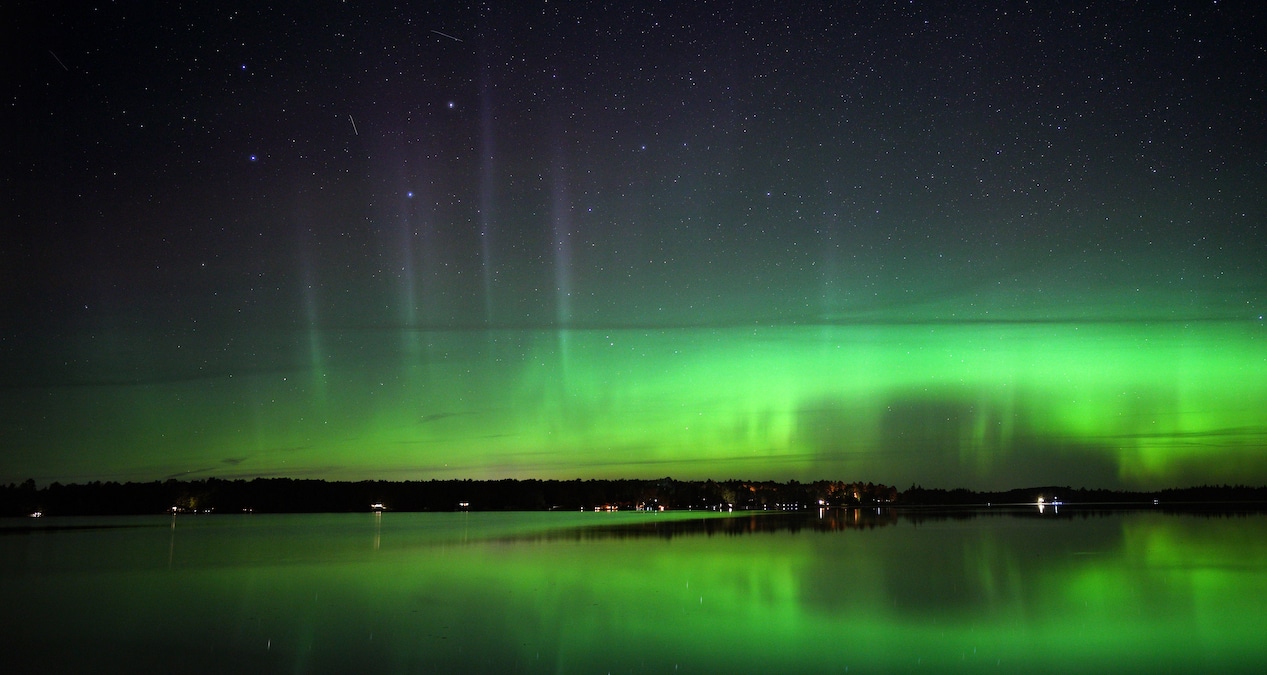Northern Lights to Be Visible in U.S. States as Far South as Kansas
By: Cristen Hemingway Jaynes
Published: July 10, 2023
 Edited by Chris McDermott
Edited by Chris McDermott

Northern Lights seen near Canyon, Minnesota on Aug. 30, 2019. Brian Peterson / Star Tribune via Getty Images
This week, U.S. States as far south as Kansas will have the opportunity to catch sight of the brilliant aurora borealis — known as the “Northern Lights” — when a solar storm dips far south enough to be seen in cities like Seattle and Boise.
The vibrant, multi-colored light show, created when solar wind collides with Earth’s atmosphere, is part of a solar cycle that started in 2019 and is expected to climax next year, reported The Associated Press.
The Northern Lights are often visible in the polar regions of Canada, Scandinavia, Iceland and Alaska, but are rarely seen so far south.
According to the University of Fairbanks’ Geophysical Institute, Thursday’s aurora display could be seen in parts of states including Washington, Idaho, Montana, Wyoming, Nebraska, North and South Dakota, Michigan, Wisconsin, Minnesota, Kansas, Ohio, Pennsylvania, New York, Massachusetts, Maryland, Vermont, New Hampshire and Maine.
Any reading of the Kp or planetary index above a five — the scale ranges from zero to nine — qualifies as a geomagnetic storm. The Geophysical Institute has predicted Thursday’s display to register as a six.
The term “aurora borealis” comes from the Latin “aurora,” which means “dawn” and “borealis,” which means “north,” Earth.com reported.
According to the National Oceanic and Atmospheric Administration’s Space Weather Prediction Center, ideal viewing times for this week’s Northern Lights display are from 10 p.m. to 2 a.m. local time.
“The aurora does not need to be directly overhead but can be observed from as much as a 1000 km away when the aurora is bright and if conditions are right,” according to the Space Weather Prediction Center. “It is the only way for most people to actually experience space weather.”
In late April of this year, a major geomagnetic storm brought spectacular lights displays as far south as Arizona, Iowa and North Dakota.
The turbulent activity of the sun can sometimes be strong enough to tug at our planet’s magnetic field, but then it recoils, creating what are called Alfvén waves about 80,000 miles up, reported NPR. When electrons get attached to a wave, they rush down toward Earth at speeds of up to 45 million miles per hour.
“Think about surfing,” said Jim Schroeder, an assistant professor of physics at Wheaton College, as NPR reported. “In order to surf, you need to paddle up to the right speed for an ocean wave to pick you up and accelerate you, and we found that electrons were surfing.”
You will not need binoculars to see this week’s auroras, but a spot with less light pollution at a higher elevation is best. Though they are called the Northern Lights, these dazzling lights are visible from all directions.
THANKS TO: https://www.ecowatch.com/northern-lights-visibility-us-states-2023.html
By: Cristen Hemingway Jaynes
Published: July 10, 2023
 Edited by Chris McDermott
Edited by Chris McDermott
Northern Lights seen near Canyon, Minnesota on Aug. 30, 2019. Brian Peterson / Star Tribune via Getty Images
This week, U.S. States as far south as Kansas will have the opportunity to catch sight of the brilliant aurora borealis — known as the “Northern Lights” — when a solar storm dips far south enough to be seen in cities like Seattle and Boise.
The vibrant, multi-colored light show, created when solar wind collides with Earth’s atmosphere, is part of a solar cycle that started in 2019 and is expected to climax next year, reported The Associated Press.
The Northern Lights are often visible in the polar regions of Canada, Scandinavia, Iceland and Alaska, but are rarely seen so far south.
According to the University of Fairbanks’ Geophysical Institute, Thursday’s aurora display could be seen in parts of states including Washington, Idaho, Montana, Wyoming, Nebraska, North and South Dakota, Michigan, Wisconsin, Minnesota, Kansas, Ohio, Pennsylvania, New York, Massachusetts, Maryland, Vermont, New Hampshire and Maine.
Any reading of the Kp or planetary index above a five — the scale ranges from zero to nine — qualifies as a geomagnetic storm. The Geophysical Institute has predicted Thursday’s display to register as a six.
The term “aurora borealis” comes from the Latin “aurora,” which means “dawn” and “borealis,” which means “north,” Earth.com reported.
According to the National Oceanic and Atmospheric Administration’s Space Weather Prediction Center, ideal viewing times for this week’s Northern Lights display are from 10 p.m. to 2 a.m. local time.
“The aurora does not need to be directly overhead but can be observed from as much as a 1000 km away when the aurora is bright and if conditions are right,” according to the Space Weather Prediction Center. “It is the only way for most people to actually experience space weather.”
In late April of this year, a major geomagnetic storm brought spectacular lights displays as far south as Arizona, Iowa and North Dakota.
The turbulent activity of the sun can sometimes be strong enough to tug at our planet’s magnetic field, but then it recoils, creating what are called Alfvén waves about 80,000 miles up, reported NPR. When electrons get attached to a wave, they rush down toward Earth at speeds of up to 45 million miles per hour.
“Think about surfing,” said Jim Schroeder, an assistant professor of physics at Wheaton College, as NPR reported. “In order to surf, you need to paddle up to the right speed for an ocean wave to pick you up and accelerate you, and we found that electrons were surfing.”
You will not need binoculars to see this week’s auroras, but a spot with less light pollution at a higher elevation is best. Though they are called the Northern Lights, these dazzling lights are visible from all directions.
THANKS TO: https://www.ecowatch.com/northern-lights-visibility-us-states-2023.html






 Sat Mar 23, 2024 11:33 pm by globalturbo
Sat Mar 23, 2024 11:33 pm by globalturbo

